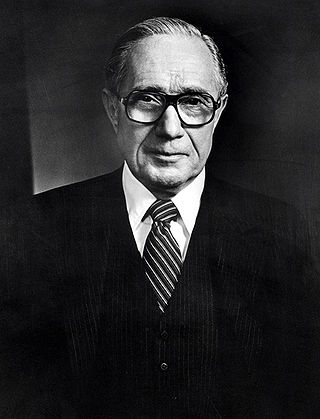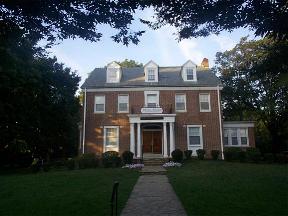Related Research Articles

Philip Morris Klutznick was a U.S. administrator who served as U.S. Secretary of Commerce from January 9, 1980, to January 19, 1981, under President Jimmy Carter. He was a prominent leader of several Jewish organisations, including as president of the World Jewish Congress from 1977 to 1979.
Jewish Texans have been a part of the history of Texas since the first European explorers arrived in the region in the 16th century. In 1990, there were around 108,000 adherents to Judaism in Texas. More recent estimates place the number at around 120,000.

Temple Israel Cemetery, also known as Pleasant Hill Cemetery, is located at 6412 North 42 Street in the North Omaha neighborhood of Omaha, Nebraska.

Jews have inhabited the city of Galveston, Texas, for almost two centuries. The first known Jewish immigrant to the Galveston area was Jao de la Porta, who, along with his brother Morin, financed the first settlement by Europeans on Galveston Island in 1816. de la Porta was born in Portugal of Jewish parentage and later became a Jewish Texan trader. In 1818, Jean Laffite appointed de la Porta supercargo for the Karankawa Indian trade. When Laffite left Galveston Island in 1820, de la Porta became a full-time trader.

Leo Morris Franklin was an influential Reform rabbi from Detroit, who headed Temple Beth El from 1899 to 1941.

Temple Beth El is a Reform synagogue located at in Bloomfield Township, Oakland County, Michigan, in the United States. Beth El was founded in 1850 in the city of Detroit, and is the oldest Jewish congregation in Michigan. Temple Beth El was a founding member of the Union for Reform Judaism in 1873, and hosted the meeting in 1889 during which the Central Conference of American Rabbis was established.

Congregation Beth Israel is a Reform Jewish congregation and synagogue, located at 10460 North 56th Street in Scottsdale, Arizona, in the United States. Incorporated in 1920, the congregation affiliated with the Union for Reform Judaism in 1935.
Congregation Am Tikvah is a combined Conservative and Reform Jewish congregation and synagogue located at 625 Brotherhood Way in San Francisco, California, in the United States. The congregation was formed in 2021 as the result of the merger of the Conservative B'nai Emunah and the Reform Beth Israel Judea congregations, with the latter formed in 1969 through a merger of the Conservative Congregation Beth Israel and the Reform Temple Judea. The congregation is affiliated with both the Union for Reform Judaism and the United Synagogue of Conservative Judaism.
The history of the Jews in Vancouver in British Columbia, Canada has been noted since the mid-19th century.

Congregation Beth Israel is a Reform Jewish congregation and synagogue located at 5600 North Braeswood Boulevard, in Houston, Texas, in the United States. The congregation, founded in 1854, is the oldest Jewish congregation in Texas; and it operates the Shlenker School.
Jews have been living in Maine, a state in the northeastern United States, for 200 years, with significant Jewish communities in Bangor as early as the 1840s and in Portland since the 1880s. The arrival of Susman Abrams in 1785 was followed by a history of immigration and settlement that parallels the history of Jewish immigration to the United States.

Anshei Sphard Beth El Emeth Congregation, abbreviated as ASBEE, was an Modern Orthodox synagogue located at 120 North East Yates Road, in East Memphis, Tennessee, in the United States. Established in 1966, with a history dating from 1861, the congregation operated for over 160 years prior to its 2023 merger with the Baron Hirsch Congregation.

The Jewish community of Houston, Texas has grown and thrived since the 1800s. As of 2008, Jews lived in many Houston neighborhoods and Meyerland is the center of the Jewish community in the area.

Few Jews arrived in Baltimore, Maryland, in its early years. As an immigrant port of entry and border town between North and South and as a manufacturing center in its own right, Baltimore has been well-positioned to reflect developments in American Jewish life. Yet, the Jewish community of Baltimore has maintained its own distinctive character as well.
Myer Samuel Kripke was an American rabbi, scholar, and philanthropist. He was based in Omaha, Nebraska.
The Mikveh Israel Cemetery Beth-El-Emeth at 55th and Market Streets is a Jewish cemetery in West Philadelphia founded in 1850 and dedicated in 1857 by Isaac Leeser’s Congregation Beth-El-Emeth as Beth-El-Emeth Cemetery.

Henry Monsky was a Jewish-American lawyer and communal leader from Omaha, Nebraska.
References
- 1 2 3 "A Street of Dreams," Nebraska Public Media. Air Date, 08/01/1994. Retrieved April 8, 2024.
- ↑ Olsen, T. (1995) Tell Me a Riddle. Rutgers University Press. p 117.
- 1 2 "History and Development of Aleph Zadik Aleph" [ permanent dead link ] B'nai B'rith Youth Organization. Retrieved 9/15/07.
- ↑ Pollack, O.B. (2001) Images of America: Jewish Life in Omaha and Lincoln; A photographic history. Arcadia Publishing. p 9.
- 1 2 Larson and Cottrell. (1997) The Gate City: A history of Omaha. University of Nebraska Press. p 115.
- ↑ "History", Temple Israel. Retrieved 9/15/07.
- 1 2 Schreiber, M. (2003) The Shengold Jewish Encyclopedia. Schreiber Publishing. p 192.
- ↑ Larson and Cottrell. (1997) p 161.
- ↑ Edgar, Irvin I. (1976) "Rabbi Leo M. Franklin: The Omaha Years (1892-1899)," Archived 2008-07-03 at the Wayback Machine Michigan Jewish History, Jewish Historical Society of Michigan, July 1976, pp. 10 - 21 (p. 11).
- ↑ Edgar (1976) p. 11.
- ↑ Baldwin, Neil. (2001) Henry Ford and the Jews: The Mass Production of Hate , Public Affairs, ISBN 1-891620-52-5, p. 125.
- 1 2 Edgar (1976) p. 14.
- ↑ Edgar (1976) p. 15.
- 1 2 3 "Nebraska - The Jewish Community" Archived 2007-09-30 at the Wayback Machine , International Association of Jewish Genealogical Societies - Cemetery Project. Retrieved 9/6/07.
- ↑ ham'asef vol. 16 chapters 20,57,72 and 73
- ↑ National Conference of Jewish Social Service. (1955) The Jewish Social Service Quarterly. p. 20.
- ↑ "Wise Memorial Hospital", Nebraska Memories website. Retrieved 1/18/08.
- ↑ "O! What a Jewish Community" Archived 2009-12-05 at the Wayback Machine , Omaha Jewish Federation, December 10, 2007
- ↑ Schroeder, Alice The Snowball A Bantam Book ISBN 978-0-553-80509-3 - September 2008, p310
- ↑ Tigay, C. "Long Before Israeli Deal, Buffett Made his Mark on Jewish Community" Archived 2011-07-26 at the Wayback Machine , Jewish Federation of Omaha. Retrieved 7/20/08.
- ↑ Pollack, O.B. (2001) p 125.
- ↑ Tenenbaum, S. (1993) A Credit to Their Community: Jewish Loan Societies in the United States. Wayne State University Press. p 149.
- ↑ Larson and Cottrell. (1997) p 158.
- ↑ "History of Beth El" Archived 2007-07-11 at the Wayback Machine . Beth El. Retrieved 9/15/07.
- ↑ "Jewish History of Omaha, Nebraska". Beit Hatfutsot Open Databases Project, The Museum of the Jewish People at Beit Hatfutsot.
- ↑ "Nebraska and the Midwest." Retrieved 9/15/07.
- ↑ ABC-Clio Information Services. (1983) The Jewish Experience in America. p 201.
- 1 2 Community directory [ permanent dead link ]. Jewish Federation of Omaha. Retrieved 9/15/07.
- ↑ Community directory Archived 2004-11-29 at the Wayback Machine . Jewish Federation of Omaha. Retrieved 9/15/07.
